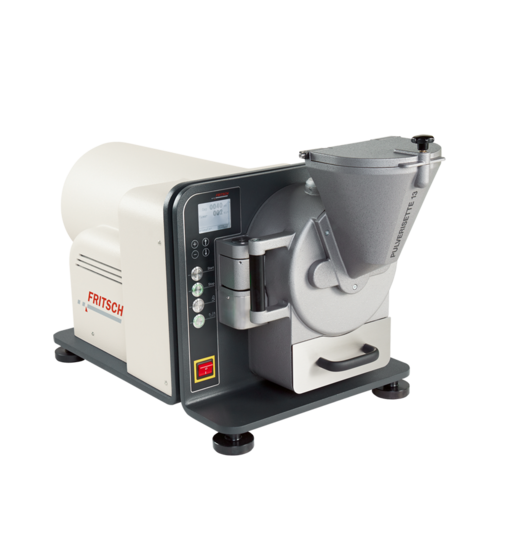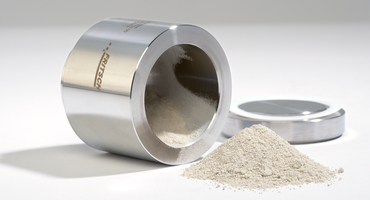Divers Broyeurs à couteaux
AUTRES GROUPES DE PRODUITS
Broyeur à couteaux universel - réglable 50-700 tr/min
PULVERISETTE 19 large
Configurez votre broyeur à couteaux universel PULVERISETTE 19 large à une vitesse de rotation variable 50 - 700 tr/min adaptée à votre application.
Parmi les nombreux accessoires, choisissez au moins une trémie d'alimentation, un jeu d'outils de coupe, une cassette à tamis et un récipient collecteur.
Trémie d'alimentation
Trémie d'alimentation étanche avec sas et coulisseau
Jeu d'outils de coupe
Rotor standard avec lames en V et contre-couteaux en acier inoxydable trempé, en métal dur carbure de tungstène ou en acier à outil sans chrome, ou
rotor avec couteaux droits entaillés et contre-couteaux en acier inoxydable trempé
rotor avec couteaux droits et contre-couteaux en acier inoxydable trempé ou en acier à outil sans chrome, ou
rotor à fraise circulaire avec plaquettes de coupe interchangeables et contre-couteaux en métal dur carbure de tungstène
Cassette à tamis
Cassettes à tamis à perforation trapézoïdale ou carrée en acier inoxydable 316L ou en acier sans chrome DC01
Récipient collecteur
Récipient collecteur de 3 litres ou récipient collecteur de grande quantités de 10 litres
Accessoires disponibles en option
Support
Support universel, support à roulettes ou support en acier inoxydable 316L
Certification
Documentation IQ/OQ destinée à aider à la qualification des appareils
Module PLC
Un module PLC permettant de contrôler le broyeur via un système de contrôle PLC et la connexion physique basée sur un bus RS485 sont disponibles sur demande.
TRÉMIE D'ALIMENTATION

Vous pouvez équiper le broyeur PULVERISETTE 19 large d'une trémie d'alimentation étanche avec sas et coulisseau destinée pour tous les matériaux courants.
TRÉMIES D'ALIMENTATION

The funnel with sample pusher for bulk solids enables due to the sample pusher a good handling and an outstanding material feeding and free-flowing bulk solids as well as straw, films or similar materials can be inserted at full length.

Funnel for bulk solids, 10 litres
Ideal for bulk solids and free-flowing materials. Particularly safe: the lid of the funnel for bulk solids is equipped with an electronic safety lock and can’t be opened during comminution.

The protected funnel made of stainless steel with plastic sample pusher, enables due to the sample pusher a good handling and an outstanding material feeding.
| General specifications | |
| Material | Stainless steel – 1.4301 |
| ISO/EN/DIN code | X5CrNi1810 |
| Chemical composition | |
| Element | Share % |
| Iron – Fe | 66.805 |
| Carbon – C | 0.070 |
| Silicon – Si | 1.000 |
| Manganese – Mn | 2.000 |
| Phosphorus – P | 0.045 |
| Sulphur – S | 0.030 |
| Chromium – Cr | 19.5 |
| Nickel – Ni | 10.5 |
| Nitrogen – N | 0.110 |
| Physical and mechanical properties | |
| Density | 7.8 g/cm³ |
| Hardness | HRB 96 |
Explanations on hardness data
RÉCIPIENTS COLLECTEURS
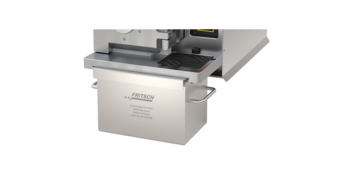
Un récipient collecteur de 3 litres est disponible. Nous recommandons d'utiliser le récipient collecteur de 10 litres pour le broyage de grande quantité.
RÉCIPIENTS COLLECTEURS
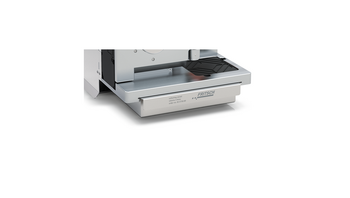
This collecting vessel has a volume of 3 litres. Collecting vessels (stainless steel are available in various sizes).
| General specifications | |
| Material | Stainless steel – 1.4404/316L |
| ISO/EN/DIN code | X2CrNiMo17-12-2 |
| Chemical composition | |
| Element | Share % |
| Iron – Fe | approx. 62.8 |
| Carbon – C | 0.03 |
| Silicon – Si | 1 |
| Manganese – Mn | 2 |
| Phosphorus – P | 0.045 |
| Sulphur – S | 0.015 |
| Chromium – Cr | 18.5 |
| Molybdenum – Mo | 2.50 |
| Nickel – Ni | 13.00 |
| Nitrogen – N | 0.110 |
| Physical and mechanical properties | |
| Density | 8.0 g/cm³ |
| Hardness | 215 HB |
Explanations on hardness data
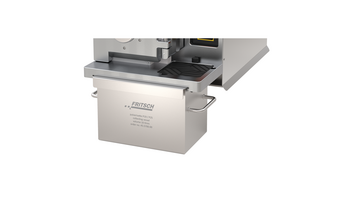
This collecting vessel is recommended for the comminution of larger sample amounts and has a volume of 10 litres.
Collecting vessels (stainless steel are available in various sizes).
| General specifications | |
| Material | Stainless steel – 1.4404/316L |
| ISO/EN/DIN code | X2CrNiMo17-12-2 |
| Chemical composition | |
| Element | Share % |
| Iron – Fe | approx. 62.8 |
| Carbon – C | 0.03 |
| Silicon – Si | 1 |
| Manganese – Mn | 2 |
| Phosphorus – P | 0.045 |
| Sulphur – S | 0.015 |
| Chromium – Cr | 18.5 |
| Molybdenum – Mo | 2.50 |
| Nickel – Ni | 13.00 |
| Nitrogen – N | 0.110 |
| Physical and mechanical properties | |
| Density | 8.0 g/cm³ |
| Hardness | 215 HB |
Explanations on hardness data
JEUX D'OUTILS DE COUPE
-
Caractéristiques des jeux d'outils de coupe et applications recommandées
Matériau et type de rotor Composant principal du matériau Résistance à l'abrasion Densité en g/cm³ Convient au broyage de Acier inoxydable trempé Fe - Cr relativement bonne 7,7 Rotor standard avec lames en V et contre-couteaux
référence 45.7000.00
Rotor avec couteaux droits entaillés et contre-couteaux en acier inoxydable trempé
référence 45.7362.00
Rotor avec couteaux droits et contre-couteaux en acier inoxydable trempé
référence 45.7352.00échantillons mi-durs, cassants, matériaux et films viscoplastiques
les échantillons moyennement durs, cassants, fibreux et élastiques ainsi que les échantillons présentant une humidité résiduelle, par exemple les denrées alimentaires, les aliments pour animaux ou les plantes provenant d'échantillons sensibles à la température, par exemple les plastiques.
échantillons mi-durs, cassants, matériaux facilement sectionnables de type foin, paille, matériaux fibreux et biologiquesMétal dur carbure de tungstène WC très bonne 12,4 Rotor avec lames en V et contre-couteaux
référence 45.7370.00
Rotor à fraise circulaire avec plaguettes de coupe interchangeables et contre-couteaux
référence 45.7200.00échantillons durs et abrasifs, matériaux durs-résistants
échantillons durs, abrasifs, fragmentation des déchets de platines qui contiennent des restes de fibres de verre et de câbles en cuivre

Le broyeur PULVERISETTE 19 large peut être équipé soit d'un rotor avec lames en V ou avec couteaux droits, soit d'un rotor à fraise circulaire. Le choix du matériau des rotors de coupe et des contre-couteaux permet d'influencer le comportement à l'abrasion au cas par cas. Tous les détails concernant les rotors de coupe et les matériaux se trouvent dans l'aide à la sélection.
Des jeux d'outils de coupe sont également disponibles en d'autres matériaux.
JEUX D'OUTILS DE COUPE EN ACIER INOXYDABLE TREMPÉ ET EN MÉTAL DUR CARBURE DE TUNGSTÈNE
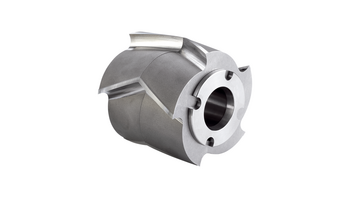
The standard rotor made of hardened stainless steel with V-cutting edges and fixed knives is suited primarily for comminution of tough-elastic materials and films due to its especially acute cutting angle and the high cutting action that results.
For sample preparation according to RoHS (for the evidence of hexavalent chromium) and for the XRF-analysis we recommend our cutting tool sets of chromium-free tool steel.
| Standard rotor with V-cutting edges and fixed knives | |
| General specifications | |
| Material | Stainless steel – 1.4112 |
| ISO/EN/DIN code | X90CrMoV18 / EN 10088 |
| Chemical composition | |
| Element | Share % |
| Iron – Fe | 79 - 77 |
| Chromium – Cr | 17 - 19 |
| Silicon – Si | 1.0 |
| Manganese – Mn | 1.0 |
| Molybdenum – Mo | 0.9 - 1.3 |
| Carbon – C | 0.85 - 0.95 |
| Vanadium – V | 0.07 - 0.012 |
| Phosphorus – P | 0.04 |
| Sulphur – S | 0.015 |
| Physical and mechanical properties | |
| Density | 7.7 g/cm³ ; |
| Hardness | 56 - 58 HRC |
Explanations on hardness data

This rotor with V-cutting edges made of hardmetal tungsten carbide comminutes the grinding material through impact and cutting forces, is suitable for hard-tough materials.
For sample preparation according to RoHS (for the evidence of hexavalent chromium) and for the XRF-analysis we recommend our cutting tool sets of chromium-free tool steel.
| 1. Rotorknives | |
| General Specification | |
| Material | Hardmetal tungsten carbide – WC |
| Chemical composition | |
| Element | Share % |
| Tungsten carbide – WC | 88 |
| Cobalt – Co | 12 |
| Physical and mechanical properties | |
| Density | 12.4 g/cm³ |
| Hardness | 89.5 HRA |
| 2. Rotorbody | |
| General specifications | |
| Material | Stainless steel– 1.4404 |
| ISO/EN/DIN Code | X2CRNiMO17-12-2 /DIN SEW410 |
| Chemical composition | |
| Element | Share % |
| Iron – Fe | 68.3 - 62.8 |
| Chromium – Cr | 16.5. - 18.5 |
| Nickel – Ni | 10.0 - 13.0 |
| Molybdenum – Mo | 2.0 - 2.5 |
| Manganese – Mn | 2.0 |
| Silicon – Si | 1.0 |
| Phosphorus – P | 0.045 |
| Carbon – C | 0.03 |
| Sulphur – S | 0.015 |
| Other – | 0.11 |
| Physical and mechanical properties | |
| Density | 8.0 g/cm³ |
| Hardness | 45 HB |
Explanations on hardness data
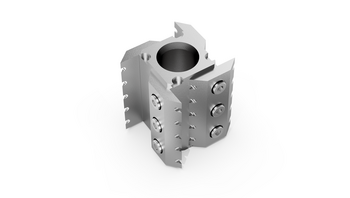
The rotor with notched edges and fixed knives made of hardened stainless steel is ideal for comminuting samples with residual moisture, such as food, feed or plants, and temperature-sensitive samples, such as plastics.
Due to its notched edges, the grinding chamber never closes completely, thus allowing optimum air flow. This significantly increases the throughput and makes the use of very fine sieves for larger quantities possible in the first place. The rotor knives have two notched cutting edges and can be easily turned after one side is used up.
Your advantage: twice the service life.
| Standard rotor with V-cutting edges and fixed knives | |
| General specifications | |
| Material | Stainless steel – 1.4112 |
| ISO/EN/DIN code | X90CrMoV18 / EN 10088 |
| Chemical composition | |
| Element | Share % |
| Iron – Fe | 79 - 77 |
| Chromium – Cr | 17 - 19 |
| Silicon – Si | 1.0 |
| Manganese – Mn | 1.0 |
| Molybdenum – Mo | 0.9 - 1.3 |
| Carbon – C | 0.85 - 0.95 |
| Vanadium – V | 0.07 - 0.012 |
| Phosphorus – P | 0.04 |
| Sulphur – S | 0.015 |
| Physical and mechanical properties | |
| Density | 7.7 g/cm³ ; |
| Hardness | 56 - 58 HRC |
Explanations on hardness data

The rotor made of tool steel with straight cutting edges which run parallel to the fixed knives is suitable for easily cut material, such as hay, straw, fibrous or biological materials. The rotor knives may be turned, since they have 2 cutting edges. Your advantage: doubling the life span of your rotor knives.
For sample preparation according to RoHS (for the evidence of hexavalent chromium) and for the XRF-analysis we recommend our cutting tool sets of chromium-free tool steel.
| 1. Rotorknives | |
| General specifications | |
| Material | Tool steel – 1.2379 |
| ISO/EN/DIN code | X155CrVMo12/1 / 59350 |
| Chemical composition | |
| Element | Share % |
| Iron – Fe | 85.79 – 82.14 |
| Carbon – C | 1.45 – 1.6 |
| Silicon – Si | 0.1 - 0.6 |
| Manganese – Mn | 0.2 – 0.6 |
| Phosphorus – P | 0.03 |
| Sulphur – S | 0.03 |
| Chromium – Cr | 11 – 13 |
| Molybdenum – Mo | 0.7 - 1 |
| Tungsten – W | 0.7 - 1 |
| Physical and mechanical properties | |
| Density | 7.85 g/cm³ ; |
| Hardness | 58-60 HV |
| 2. Rotor body | |
| General specifications | |
| Material | Construction steel – 1.0037 – FeP03 |
| ISO/EN/DIN code | S235 JR |
| Chemical composition | |
| Element | Share % |
| Iron – Fe | 98.34 |
| Carbon – C | 0.17 |
| Manganese – Mn | 1.4 |
| Phosphorus – P | 0.045 |
| Sulphur – S | 0.045 |
| Chromium – Cr | 1.660 |
| Physical and mechanical properties | |
| Density | 7.85 g/cm³ |
| Hardness | 20-95 HV |
Explanations on hardness data
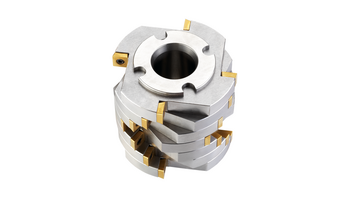
This disk milling cutter rotor with indexable inserts and fixed knives made of hardmetal tungsten carbide offers the greatest resilience and the best stability of the knives. The rotor is even suitable for scrap circuit board with glass fibre residue and copper cable.
With the disk milling cutter rotor, the cutting plates can be turned four times and replaced individually. Damage or wear will never again make it necessary to buy a completely new rotor.
For sample preparation according to RoHS (for the evidence of hexavalent chromium) and for the XRF-analysis we recommend our cutting tool sets of chromium free tool steel.
| 1. Rotorknives | |
| General Specification | |
| Material | Hardmetal tungsten carbide – WC |
| Chemical composition | |
| Element | Share % |
| Tungsten carbide – WC | 88 |
| Cobalt – Co | 12 |
| Physical and mechanical properties | |
| Density | 12.4 g/cm³ |
| Hardness | 89.5 HRA |
| 2. Rotorbody | |
| General specifications | |
| Material | Stainless steel– 1.4404 |
| ISO/EN/DIN Code | X2CRNiMO17-12-2 /DIN SEW410 |
| Chemical composition | |
| Element | Share % |
| Iron – Fe | 68.3 - 62.8 |
| Chromium – Cr | 16.5. - 18.5 |
| Nickel – Ni | 10.0 - 13.0 |
| Molybdenum – Mo | 2.0 - 2.5 |
| Manganese – Mn | 2.0 |
| Silicon – Si | 1.0 |
| Phosphorus – P | 0.045 |
| Carbon – C | 0.03 |
| Sulphur – S | 0.015 |
| Other – | 0.11 |
| Physical and mechanical properties | |
| Density | 8.0 g/cm³ |
| Hardness | 45 HB |
Explanations on hardness data
The disk milling cutter rotor with large chip chambers, indexable inserts and fixed knives made
of hardmetal tungsten carbide is suited for grinding large sample amounts.
The especially robust disk milling cutter rotor with large chip chambers, indexable inserts and fixed knives can even comminute circuit board scrap with glass fibre residue and copper cable.
Quadruple service life: With the disk milling cutter rotor, the cutting plates can be turned four times and replaced individually. Damage or wear are no longer a reason to buy a completely new rotor.
For sample preparation according to RoHS (for the evidence of hexavalent chromium) and for the XRF-analysis we recommend our cutting tool sets of chromium-free tool steel.
| 1. Rotorknives | |
| General Specification | |
| Material | Hardmetal tungsten carbide – WC |
| Chemical composition | |
| Element | Share % |
| Tungsten carbide – WC | 88 |
| Cobalt – Co | 12 |
| Physical and mechanical properties | |
| Density | 12.4 g/cm³ |
| Hardness | 89.5 HRA |
| 2. Rotorbody | |
| General specifications | |
| Material | Stainless steel– 1.4404 |
| ISO/EN/DIN Code | X2CRNiMO17-12-2 /DIN SEW410 |
| Chemical composition | |
| Element | Share % |
| Iron – Fe | 68.3 - 62.8 |
| Chromium – Cr | 16.5. - 18.5 |
| Nickel – Ni | 10.0 - 13.0 |
| Molybdenum – Mo | 2.0 - 2.5 |
| Manganese – Mn | 2.0 |
| Silicon – Si | 1.0 |
| Phosphorus – P | 0.045 |
| Carbon – C | 0.03 |
| Sulphur – S | 0.015 |
| Other – | 0.11 |
| Physical and mechanical properties | |
| Density | 8.0 g/cm³ |
| Hardness | 45 HB |
Explanations on hardness data
CASSETTES À TAMIS en acier inoxydable 316L

Les cassettes à tamis déterminent la granulométrie finale de l'échantillon. Elles assurent un écart constant entre le rotor et l'échantillon et donc le meilleur résultat possible. Des cassettes à tamis à perforation trapézoïdale et à perforation carrée sont disponibles. Les cassettes à tamis à perforation trapézoïdale provoquent une fragmentation supplémentaire résultant du cisaillement plus important. Les cassettes à tamis à perforation carrée sont recommandées pour fragmenter des matériaux cassants et des matériaux de finesse moyenne à plage granulométrique étroite. Les cassettes à tamis sont aussi disponibles avec d'autres perforations.
CASSETTES À TAMIS EN ACIER INOXYDABLE 316L
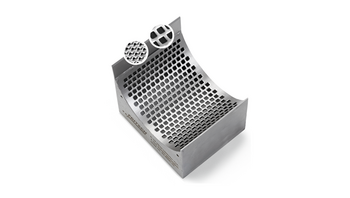
Sieve cassettes determine the final fineness of a sample.
Sieve cassettes with trapezoidal and square perforations are offered. Sieve cassettes with trapezoidal perforations improve size reduction through extra shearing action. Sieve cassettes with square perforations are used for the grinding of brittle materials and materials of medium fineness with a narrow grain band.
Sieve cassettes made of chromium-free steel DC01 are especially recommended for the sample preparation according to RoHS or for verification of hexavalent chromium and for the XRF analysis. For all other applications sieve cassettes made stainless steel can be used since these are harder and therefore more resilient against abrasion.
| General specifications | |
| Material | Stainless steel – 1.4404/316L |
| ISO/EN/DIN code | X2CrNiMo17-12-2 |
| Chemical composition | |
| Element | Share % |
| Iron – Fe | approx. 62.8 |
| Carbon – C | 0.03 |
| Silicon – Si | 1 |
| Manganese – Mn | 2 |
| Phosphorus – P | 0.045 |
| Sulphur – S | 0.015 |
| Chromium – Cr | 18.5 |
| Molybdenum – Mo | 2.50 |
| Nickel – Ni | 13.00 |
| Nitrogen – N | 0.110 |
| Physical and mechanical properties | |
| Density | 8.0 g/cm³ |
| Hardness | 215 HB |
Explanations on hardness data

Sieve cassettes determine the final fineness of a sample.
Sieve cassettes with trapezoidal and square perforations are offered. Sieve cassettes with trapezoidal perforations improve size reduction through extra shearing action. Sieve cassettes with square perforations are used for the grinding of brittle materials and materials of medium fineness with a narrow grain band.
Sieve cassettes made of chromium-free steel DC01 are especially recommended for the sample preparation according to RoHS or for verification of hexavalent chromium and for the XRF analysis. For all other applications sieve cassettes made stainless steel can be used since these are harder and therefore more resilient against abrasion.
| General specifications | |
| Material | Stainless steel – 1.4404/316L |
| ISO/EN/DIN code | X2CrNiMo17-12-2 |
| Chemical composition | |
| Element | Share % |
| Iron – Fe | approx. 62.8 |
| Carbon – C | 0.03 |
| Silicon – Si | 1 |
| Manganese – Mn | 2 |
| Phosphorus – P | 0.045 |
| Sulphur – S | 0.015 |
| Chromium – Cr | 18.5 |
| Molybdenum – Mo | 2.50 |
| Nickel – Ni | 13.00 |
| Nitrogen – N | 0.110 |
| Physical and mechanical properties | |
| Density | 8.0 g/cm³ |
| Hardness | 215 HB |
Explanations on hardness data

Sieve cassettes determine the final fineness of a sample.
Sieve cassettes with trapezoidal and square perforations are offered. Sieve cassettes with trapezoidal perforations improve size reduction through extra shearing action. Sieve cassettes with square perforations are used for the grinding of brittle materials and materials of medium fineness with a narrow grain band.
Sieve cassettes made of chromium-free steel DC01 are especially recommended for the sample preparation according to RoHS or for verification of hexavalent chromium and for the XRF analysis. For all other applications sieve cassettes made stainless steel can be used since these are harder and therefore more resilient against abrasion.
| General specifications | |
| Material | Stainless steel – 1.4404/316L |
| ISO/EN/DIN code | X2CrNiMo17-12-2 |
| Chemical composition | |
| Element | Share % |
| Iron – Fe | approx. 62.8 |
| Carbon – C | 0.03 |
| Silicon – Si | 1 |
| Manganese – Mn | 2 |
| Phosphorus – P | 0.045 |
| Sulphur – S | 0.015 |
| Chromium – Cr | 18.5 |
| Molybdenum – Mo | 2.50 |
| Nickel – Ni | 13.00 |
| Nitrogen – N | 0.110 |
| Physical and mechanical properties | |
| Density | 8.0 g/cm³ |
| Hardness | 215 HB |
Explanations on hardness data

Sieve cassettes determine the final fineness of a sample.
Sieve cassettes with trapezoidal and square perforations are offered. Sieve cassettes with trapezoidal perforations improve size reduction through extra shearing action. Sieve cassettes with square perforations are used for the grinding of brittle materials and materials of medium fineness with a narrow grain band.
Sieve cassettes made of chromium-free steel DC01 are especially recommended for the sample preparation according to RoHS or for verification of hexavalent chromium and for the XRF analysis. For all other applications sieve cassettes made stainless steel can be used since these are harder and therefore more resilient against abrasion.
| General specifications | |
| Material | Stainless steel – 1.4404/316L |
| ISO/EN/DIN code | X2CrNiMo17-12-2 |
| Chemical composition | |
| Element | Share % |
| Iron – Fe | approx. 62.8 |
| Carbon – C | 0.03 |
| Silicon – Si | 1 |
| Manganese – Mn | 2 |
| Phosphorus – P | 0.045 |
| Sulphur – S | 0.015 |
| Chromium – Cr | 18.5 |
| Molybdenum – Mo | 2.50 |
| Nickel – Ni | 13.00 |
| Nitrogen – N | 0.110 |
| Physical and mechanical properties | |
| Density | 8.0 g/cm³ |
| Hardness | 215 HB |
Explanations on hardness data

Sieve cassettes determine the final fineness of a sample.
Sieve cassettes with trapezoidal and square perforations are offered. Sieve cassettes with trapezoidal perforations improve size reduction through extra shearing action. Sieve cassettes with square perforations are used for the grinding of brittle materials and materials of medium fineness with a narrow grain band.
Sieve cassettes made of chromium-free steel DC01 are especially recommended for the sample preparation according to RoHS or for verification of hexavalent chromium and for the XRF analysis. For all other applications sieve cassettes made stainless steel can be used since these are harder and therefore more resilient against abrasion.
| General specifications | |
| Material | Stainless steel – 1.4404/316L |
| ISO/EN/DIN code | X2CrNiMo17-12-2 |
| Chemical composition | |
| Element | Share % |
| Iron – Fe | approx. 62.8 |
| Carbon – C | 0.03 |
| Silicon – Si | 1 |
| Manganese – Mn | 2 |
| Phosphorus – P | 0.045 |
| Sulphur – S | 0.015 |
| Chromium – Cr | 18.5 |
| Molybdenum – Mo | 2.50 |
| Nickel – Ni | 13.00 |
| Nitrogen – N | 0.110 |
| Physical and mechanical properties | |
| Density | 8.0 g/cm³ |
| Hardness | 215 HB |
Explanations on hardness data

Sieve cassettes determine the final fineness of a sample.
Sieve cassettes with trapezoidal and square perforations are offered. Sieve cassetteswith trapezoidal perforations improve size reduction through extra shearing action. Sieve cassettes with square perforations are used for the grinding of brittle materials and materials of medium fineness with a narrow grain band.
Sieve cassettes made of chromium-free steel DC01 are especially recommended for the sample preparation according to RoHS or for verification of hexavalent chromium and for the XRF analysis. For all other applications sieve cassettes made stainless steel can be used since these are harder and therefore more resilient against abrasion.
| General specifications | |
| Material | Stainless steel – 1.4404/316L |
| ISO/EN/DIN code | X2CrNiMo17-12-2 |
| Chemical composition | |
| Element | Share % |
| Iron – Fe | approx. 62.8 |
| Carbon – C | 0.03 |
| Silicon – Si | 1 |
| Manganese – Mn | 2 |
| Phosphorus – P | 0.045 |
| Sulphur – S | 0.015 |
| Chromium – Cr | 18.5 |
| Molybdenum – Mo | 2.50 |
| Nickel – Ni | 13.00 |
| Nitrogen – N | 0.110 |
| Physical and mechanical properties | |
| Density | 8.0 g/cm³ |
| Hardness | 215 HB |
Explanations on hardness data

Sieve cassettes determine the final fineness of a sample.
Sieve cassettes with trapezoidal and square perforations are offered. Sieve cassetteswith trapezoidal perforations improve size reduction through extra shearing action. Sieve cassettes with square perforations are used for the grinding of brittle materials and materials of medium fineness with a narrow grain band.
Sieve cassettes made of chromium-free steel DC01 are especially recommended for the sample preparation according to RoHS or for verification of hexavalent chromium and for the XRF analysis. For all other applications sieve cassettes made stainless steel can be used since these are harder and therefore more resilient against abrasion.
| General specifications | |
| Material | Stainless steel – 1.4404/316L |
| ISO/EN/DIN code | X2CrNiMo17-12-2 |
| Chemical composition | |
| Element | Share % |
| Iron – Fe | approx. 62.8 |
| Carbon – C | 0.03 |
| Silicon – Si | 1 |
| Manganese – Mn | 2 |
| Phosphorus – P | 0.045 |
| Sulphur – S | 0.015 |
| Chromium – Cr | 18.5 |
| Molybdenum – Mo | 2.50 |
| Nickel – Ni | 13.00 |
| Nitrogen – N | 0.110 |
| Physical and mechanical properties | |
| Density | 8.0 g/cm³ |
| Hardness | 215 HB |
Explanations on hardness data

Sieve cassettes determine the final fineness of a sample.
Sieve cassettes with trapezoidal and square perforations are offered. Sieve cassettes with trapezoidal perforations improve size reduction through extra shearing action. Sieve cassettes with square perforations are used for the grinding of brittle materials and materials of medium fineness with a narrow grain band.
Sieve cassettes made of chromium-free steel DC01 are especially recommended for the sample preparation according to RoHS or for verification of hexavalent chromium and for the XRF analysis. For all other applications sieve cassettes made stainless steel can be used since these are harder and therefore more resilient against abrasion.
| General specifications | |
| Material | Stainless steel – 1.4404/316L |
| ISO/EN/DIN code | X2CrNiMo17-12-2 |
| Chemical composition | |
| Element | Share % |
| Iron – Fe | approx. 62.8 |
| Carbon – C | 0.03 |
| Silicon – Si | 1 |
| Manganese – Mn | 2 |
| Phosphorus – P | 0.045 |
| Sulphur – S | 0.015 |
| Chromium – Cr | 18.5 |
| Molybdenum – Mo | 2.50 |
| Nickel – Ni | 13.00 |
| Nitrogen – N | 0.110 |
| Physical and mechanical properties | |
| Density | 8.0 g/cm³ |
| Hardness | 215 HB |
Explanations on hardness data

Sieve cassettes determine the final fineness of a sample.
Sieve cassettes with trapezoidal and square perforations are offered. Sieve cassettes with trapezoidal perforations improve size reduction through extra shearing action. Sieve cassettes with square perforations are used for the grinding of brittle materials and materials of medium fineness with a narrow grain band.
Sieve cassettes made of chromium-free steel DC01 are especially recommended for the sample preparation according to RoHS or for the verification of hexavalent chromium and for the XRF analysis. For all other applications sieve cassettes made stainless steel can be used since these are harder and therefore more resilient against abrasion.
| General specifications | |
| Material | Stainless steel – 1.4404/316L |
| ISO/EN/DIN code | X2CrNiMo17-12-2 |
| Chemical composition | |
| Element | Share % |
| Iron – Fe | approx. 62.8 |
| Carbon – C | 0.03 |
| Silicon – Si | 1 |
| Manganese – Mn | 2 |
| Phosphorus – P | 0.045 |
| Sulphur – S | 0.015 |
| Chromium – Cr | 18.5 |
| Molybdenum – Mo | 2.50 |
| Nickel – Ni | 13.00 |
| Nitrogen – N | 0.110 |
| Physical and mechanical properties | |
| Density | 8.0 g/cm³ |
| Hardness | 215 HB |
Explanations on hardness data

Sieve cassettes determine the final fineness of a sample.
Sieve inserts with trapezoidal and square perforations are offered. Sieve cassettes with trapezoidal perforations improve size reduction through extra shearing action. Sieve cassettes with square perforations are used for the grinding of brittle materials and materials of medium fineness with a narrow grain band.
Sieve cassettes made of chromium-free steel DC01 are especially recommended for the sample preparation according to RoHS or for verification of hexavalent chromium and for the XRF analysis. For all other applications sieve cassettes made stainless steel can be used since these are harder and therefore more resilient against abrasion.
| General specifications | |
| Material | Stainless steel – 1.4404/316L |
| ISO/EN/DIN code | X2CrNiMo17-12-2 |
| Chemical composition | |
| Element | Share % |
| Iron – Fe | approx. 62.8 |
| Carbon – C | 0.03 |
| Silicon – Si | 1 |
| Manganese – Mn | 2 |
| Phosphorus – P | 0.045 |
| Sulphur – S | 0.015 |
| Chromium – Cr | 18.5 |
| Molybdenum – Mo | 2.50 |
| Nickel – Ni | 13.00 |
| Nitrogen – N | 0.110 |
| Physical and mechanical properties | |
| Density | 8.0 g/cm³ |
| Hardness | 215 HB |
Explanations on hardness data

Sieve cassettes determine the final fineness of a sample.
Sieve inserts with trapezoidal and square perforations are offered. Sieve cassettes with trapezoidal perforations improve size reduction through extra shearing action. Sieve cassettes with square perforations are used for the grinding of brittle materials and materials of medium fineness with a narrow grain band.
Sieve cassettes made of chromium-free steel DC01 are especially recommended for the sample preparation according to RoHS or for verification of hexavalent chromium and for the XRF analysis. For all other applications sieve cassettes made stainless steel can be used since these are harder and therefore more resilient against abrasion.
| General specifications | |
| Material | Stainless steel – 1.4404/316L |
| ISO/EN/DIN code | X2CrNiMo17-12-2 |
| Chemical composition | |
| Element | Share % |
| Iron – Fe | approx. 62.8 |
| Carbon – C | 0.03 |
| Silicon – Si | 1 |
| Manganese – Mn | 2 |
| Phosphorus – P | 0.045 |
| Sulphur – S | 0.015 |
| Chromium – Cr | 18.5 |
| Molybdenum – Mo | 2.50 |
| Nickel – Ni | 13.00 |
| Nitrogen – N | 0.110 |
| Physical and mechanical properties | |
| Density | 8.0 g/cm³ |
| Hardness | 215 HB |
Explanations on hardness data
ACCESSOIRES POUR BROYAGE SANS CHROME
-
Caractéristiques des jeux d'outils de coupe de fragmentation sans chrome et applications recommandées
Matériau et type de rotor Composant principal du matériau Résistance à l'abrasion Densité en g/cm³ Convient au broyage de Acier à outil sans chrome Fe relativement bonne 7,8 Rotor avec lames en V et contre-couteaux
référence 45.7112.00
le rotor est parfaitement adapté à la préparation d'échantillons selon RoHS, par exemple pour prouver la présence de chrome hexavalent et pour l'analyse XRFéchantillons cassants, durs, matériaux et films viscoélastiques

Lorsqu'une préparation d'échantillon conforme à RoHS (destinée par exemple à prouver la présence de chrome hexavalent) ou à des analyses XRF doits impérativement assurer une fragmentation garantie sans chrome, les jeux d'outils de coupe FRITSCH en acier à outil sans chrome et les cassettes à tamis en acier sans chrome DC01 vous donnent la sécurité nécessaire.
JEU D'OUTILS DE COUPE EN ACIER À OUTIL SANS CHROME

The rotors made of chromium-free tool steel are especially recommended for the sample preparation according to RoHS and for the XRF-analysis. If a chromium-free size reduction is required for sample preparation according to RoHS – for example for verification of hexavalent chromium – or for XRF analysis, FRITSCH cutting tool sets of chromium-free tool steel offer this absolute assurance. Because for FRITSCH Cutting Mills, the fixed knives are always of the same material as the cutting edges of the rotor.
The rotor made of chromium-free tool steel with V-cutting edges and fixed knives is suited primarily for comminution of tough-elastic materials and films due to its especially acute cutting angle and the high cutting action that results.
For all other applications we recommend our cutting tool sets made of tool steel and hardmetal tungsten carbide and therefore are more resilient against abrasion.
| General specifications | |
| Material | Construction steel - 1.0330 - not rust-proof |
| ISO/EN/DIN code | DC01, EN 1013 |
| Chemical composition | |
| Element | Share % |
| Iron – Fe | 99.19 |
| Carbon – C | 0.12 |
| Manganese – Mn | 0.6 |
| Phosphorus – P | 0.045 |
| Sulphur – S | 0.045 |
| Physical and mechanical properties | |
| Density | 7.85 g/cm³ |
| Hardness | 86 HRA |
Explanations on hardness data
CASSETTES À TAMIS EN ACIER SANS CHROME DC01

Sieve cassettes made of chromium-free steel DC01 are especially recommended for the sample preparation according to RoHS or for verification of hexavalent chromium and for the XRF analysis. For all other applications sieve cassettes made stainless steel can be used since these are harder and therefore more resilient against abrasion.
Sieve cassettes determine the final fineness of a sample.
Sieve cassettes with trapezoidal and square perforations are offered. Sieve cassettes with trapezoidal perforations improve size reduction through extra shearing action. Sieve cassettes with square perforations are used for the grinding of brittle materials and materials of medium fineness with a narrow grain band.
| General specifications | |
| Material | Construction steel - 1.0330 - not rust-proof |
| ISO/EN/DIN code | DC01, EN 1013 |
| Chemical composition | |
| Element | Share % |
| Iron – Fe | 99.19 |
| Carbon – C | 0.12 |
| Manganese – Mn | 0.6 |
| Phosphorus – P | 0.045 |
| Sulphur – S | 0.045 |
| Physical and mechanical properties | |
| Density | 7.85 g/cm³ |
| Hardness | 86 HRA |
Explanations on hardness data

Sieve cassettes made of chromium-free steel DC01 are especially recommended for the sample preparation according to RoHS or for verification of hexavalent chromium and for the XRF analysis. For all other applications sieve cassettes made stainless steel can be used since these are harder and therefore more resilient against abrasion.
Sieve cassettes determine the final fineness of a sample.
Sieve inserts with trapezoidal and square perforations are offered. Sieve inserts with trapezoidal perforations improve size reduction through extra shearing action. Sieve inserts with square perforations are used for the grinding of brittle materials and materials of medium fineness with a narrow grain band.
| General specifications | |
| Material | Construction steel - 1.0330 - not rust-proof |
| ISO/EN/DIN code | DC01, EN 1013 |
| Chemical composition | |
| Element | Share % |
| Iron – Fe | 99.19 |
| Carbon – C | 0.12 |
| Manganese – Mn | 0.6 |
| Phosphorus – P | 0.045 |
| Sulphur – S | 0.045 |
| Physical and mechanical properties | |
| Density | 7.85 g/cm³ |
| Hardness | 86 HRA |
Explanations on hardness data

Sieve cassettes made of chromium-free steel DC01 are especially recommended for the sample preparation according to RoHS or for verification of hexavalent chromium and for the XRF analysis. For all other applications sieve cassettes made stainless steel can be used since these are harder and therefore more resilient against abrasion.
Sieve cassettes determine the final fineness of a sample.
Sieve cassettes with trapezoidal and square perforations are offered. Sieve cassettes with trapezoidal perforations improve size reduction through extra shearing action. Sieve cassettes with square perforations are used for the grinding of brittle materials and materials of medium fineness with a narrow grain band.
| General specifications | |
| Material | Construction steel - 1.0330 - not rust-proof |
| ISO/EN/DIN code | DC01, EN 1013 |
| Chemical composition | |
| Element | Share % |
| Iron – Fe | 99.19 |
| Carbon – C | 0.12 |
| Manganese – Mn | 0.6 |
| Phosphorus – P | 0.045 |
| Sulphur – S | 0.045 |
| Physical and mechanical properties | |
| Density | 7.85 g/cm³ |
| Hardness | 86 HRA |
Explanations on hardness data

Sieve cassettes made of chromium-free steel DC01 are especially recommended for the sample preparation according to RoHS or for verification of hexavalent chromium and for the XRF analysis. For all other applications sieve cassettes made stainless steel can be used since these are harder and therefore more resilient against abrasion.
Sieve cassettes determine the final fineness of a sample.
Sieve cassettes with trapezoidal and square perforations are offered. Sieve cassettes with trapezoidal perforations improve size reduction through extra shearing action. Sievecassettes with square perforations are used for the grinding of brittle materials and materials of medium fineness with a narrow grain band.
| General specifications | |
| Material | Construction steel - 1.0330 - not rust-proof |
| ISO/EN/DIN code | DC01, EN 1013 |
| Chemical composition | |
| Element | Share % |
| Iron – Fe | 99.19 |
| Carbon – C | 0.12 |
| Manganese – Mn | 0.6 |
| Phosphorus – P | 0.045 |
| Sulphur – S | 0.045 |
| Physical and mechanical properties | |
| Density | 7.85 g/cm³ |
| Hardness | 86 HRA |
Explanations on hardness data

Sieve cassettes made of chromium-free steel DC01 are especially recommended for the sample preparation according to RoHS or for verification of hexavalent chromium and for the XRF analysis. For all other applications sieve cassettes made stainless steel can be used since these are harder and therefore more resilient against abrasion.
Sieve cassettes determine the final fineness of a sample.
Sieve cassettes with trapezoidal and square perforations are offered. Sieve cassettes with trapezoidal perforations improve size reduction through extra shearing action. Sieve cassettes with square perforations are used for the grinding of brittle materials and materials of medium fineness with a narrow grain band.
| General specifications | |
| Material | Construction steel - 1.0330 - not rust-proof |
| ISO/EN/DIN code | DC01, EN 1013 |
| Chemical composition | |
| Element | Share % |
| Iron – Fe | 99.19 |
| Carbon – C | 0.12 |
| Manganese – Mn | 0.6 |
| Phosphorus – P | 0.045 |
| Sulphur – S | 0.045 |
| Physical and mechanical properties | |
| Density | 7.85 g/cm³ |
| Hardness | 86 HRA |
Explanations on hardness data

Sieve cassettes made of chromium-free steel DC01 are especially recommended for the sample preparation according to RoHS or for verification of hexavalent chromium and for the XRF analysis. For all other applications sieve cassettes made stainless steel can be used since these are harder and therefore more resilient against abrasion.
Sieve cassettes determine the final fineness of a sample.
Sieve cassettes with trapezoidal and square perforations are offered. Sieve cassettes with trapezoidal perforations improve size reduction through extra shearing action. Sieve inserts with square perforations are used for the grinding of brittle materials and materials of medium fineness with a narrow grain band.
| General specifications | |
| Material | Construction steel - 1.0330 - not rust-proof |
| ISO/EN/DIN code | DC01, EN 1013 |
| Chemical composition | |
| Element | Share % |
| Iron – Fe | 99.19 |
| Carbon – C | 0.12 |
| Manganese – Mn | 0.6 |
| Phosphorus – P | 0.045 |
| Sulphur – S | 0.045 |
| Physical and mechanical properties | |
| Density | 7.85 g/cm³ |
| Hardness | 86 HRA |
Explanations on hardness data

Sieve cassettes made of chromium-free steel DC01 are especially recommended for the sample preparation according to RoHS or for verification of hexavalent chromium and for the XRF analysis. For all other applications sieve cassettes made stainless steel can be used since these are harder and therefore more resilient against abrasion.
Sieve cassettes determine the final fineness of a sample.
Sieve cassettes with trapezoidal and square perforations are offered. Sieve cassettes with trapezoidal perforations improve size reduction through extra shearing action. Sieve inserts with square perforations are used for the grinding of brittle materials and materials of medium fineness with a narrow grain band.
| General specifications | |
| Material | Construction steel - 1.0330 - not rust-proof |
| ISO/EN/DIN code | DC01, EN 1013 |
| Chemical composition | |
| Element | Share % |
| Iron – Fe | 99.19 |
| Carbon – C | 0.12 |
| Manganese – Mn | 0.6 |
| Phosphorus – P | 0.045 |
| Sulphur – S | 0.045 |
| Physical and mechanical properties | |
| Density | 7.85 g/cm³ |
| Hardness | 86 HRA |
Explanations on hardness data
DISPOSITIF D'ASPIRATION D'ÉCHANTILLON AVEC CYCLONES
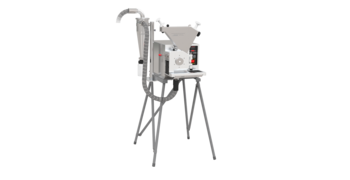
La combinaison brevetée du broyeur à couteaux universel et du cyclones haute performance facilite le nettoyage et le remplissage, permet d'utiliser des cassettes à tamis plus fines pour obtenir des granulométries finales plus petites, accélère le débit, maintient la contrainte thermique des échantillons à un niveau réduit, même lorsque les échantillons sont difficiles à broyer.
CYCLONES HAUTE PERFORMANCE

The FRITSCH high-performance Cyclone separator completely made of stainless steel 316L is particularly indispensable in the analytical sector and in the food and pharmaceutical industries, and for the processing of heterogeneous mixtures of material, e.g. in the cement industry. Due to its high surface quality, it offers enhanced resistance to corrosive media such as alkalis and acids and is especially easy to clean with a wide range of possible cleaning agents, without leaving any residues. The comminuted sample is drawn into a screwed-on collecting vessel or in a smaller sample glass, in which it can also be transported and stored. In addition, it can be completely dismantled, fully emptied, flooded and sterilised, and thus offers reliable protection against cross-contamination.
The advantages of the high-performance Cyclone separator at a glance
- Faster throughput
- Improved discharge of material from the grinding chamber
- Additional strong cooling of the grinding material and grinding parts
- Efficient size reduction of temperature-sensitive samples, electrostatically-charged plastics or powder coatings
- Ideal for light materials, small sample quantities and finer sieve sizes
- Highly efficient continuous comminution of large quantities
| General specifications | |
| Material | Stainless steel – 1.4301 |
| ISO/EN/DIN code | X5CrNi1810 |
| Chemical composition | |
| Element | Share % |
| Iron – Fe | 66.805 |
| Carbon – C | 0.070 |
| Silicon – Si | 1.000 |
| Manganese – Mn | 2.000 |
| Phosphorus – P | 0.045 |
| Sulphur – S | 0.030 |
| Chromium – Cr | 19.5 |
| Nickel – Ni | 10.5 |
| Nitrogen – N | 0.110 |
| Physical and mechanical properties | |
| Density | 7.8 g/cm³ |
| Hardness | HRB 96 |
Explanations on hardness data

The FRITSCH high-performance Cyclone separator completely made of stainless steel 316L is particularly indispensable in the analytical sector and in the food and pharmaceutical industries, and for the processing of heterogeneous mixtures of material, e.g. in the cement industry. Due to its high surface quality, it offers enhanced resistance to corrosive media such as alkalis and acids and is especially easy to clean with a wide range of possible cleaning agents, without leaving any residues. The comminuted sample is drawn into a screwed-on collecting vessel or in a smaller sample glass, in which it can also be transported and stored. In addition, it can be completely dismantled, fully emptied, flooded and sterilised, and thus offers reliable protection against cross-contamination.
The advantages of the high-performance Cyclone separator at a glance
- Faster throughput - Improved discharge of material from the grinding chamber
- Additional strong cooling of the grinding material and grinding parts
- Efficient size reduction of temperature-sensitive samples, electrostatically-charged plastics or powder coatings
- Ideal for light materials, small sample quantities and finer sieve sizes
- Highly efficient continuous comminution of large quantities
| General specifications | |
| Material | Stainless steel – 1.4301 |
| ISO/EN/DIN code | X5CrNi1810 |
| Chemical composition | |
| Element | Share % |
| Iron – Fe | 66.805 |
| Carbon – C | 0.070 |
| Silicon – Si | 1.000 |
| Manganese – Mn | 2.000 |
| Phosphorus – P | 0.045 |
| Sulphur – S | 0.030 |
| Chromium – Cr | 19.5 |
| Nickel – Ni | 10.5 |
| Nitrogen – N | 0.110 |
| Physical and mechanical properties | |
| Density | 7.8 g/cm³ |
| Hardness | HRB 96 |
Explanations on hardness data
RÉCIPIENTS COLLECTEUR POUR CYCLONES HAUTE PERFORMANCE
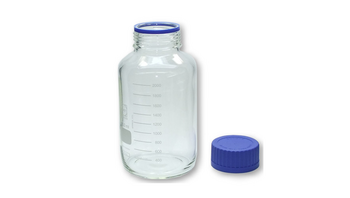
Sample glass 1 litre for sample exhaustion with the high-performance Cyclone separator.

The sample glass with 2 litres volume is recommended for sample exhaustion with the high-performance Cyclone separator for sample discharges larger than 1000 ml, since only a 1 litre sample glass is included in the delivery of the high-performance Cyclone separator.

The sample glass with 5 litres volume is recommended for sample exhaustion with the high-performance Cyclone separator for sample discharges larger than 1000 ml, since only a 1 litre sample glass is included in the delivery of the high-performance Cyclone separator.
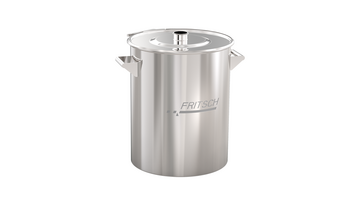
The collecting vessel 20 litres is recommended for sample exhaustion with the high-performance Cyclone separator for sample discharges larger than 1000 ml, since only a 1 litre sample glass is included in the delivery of the high-performance Cyclone separator.
| General specifications | |
| Material | Stainless steel – 1.4404/316L |
| ISO/EN/DIN code | X2CrNiMo17-12-2 |
| Chemical composition | |
| Element | Share % |
| Iron – Fe | approx. 62.8 |
| Carbon – C | 0.03 |
| Silicon – Si | 1 |
| Manganese – Mn | 2 |
| Phosphorus – P | 0.045 |
| Sulphur – S | 0.015 |
| Chromium – Cr | 18.5 |
| Molybdenum – Mo | 2.50 |
| Nickel – Ni | 13.00 |
| Nitrogen – N | 0.110 |
| Physical and mechanical properties | |
| Density | 8.0 g/cm³ |
| Hardness | 215 HB |
Explanations on hardness data

The collecting vessel 60 litres is recommended for sample exhaustion with the high-performance Cyclone separator for sample discharges larger than 1000 ml, since only a 1 litre sample glass is included in the delivery of the high-performance Cyclone separator.
| General specifications | |
| Material | Stainless steel – 1.4404/316L |
| ISO/EN/DIN code | X2CrNiMo17-12-2 |
| Chemical composition | |
| Element | Share % |
| Iron – Fe | approx. 62.8 |
| Carbon – C | 0.03 |
| Silicon – Si | 1 |
| Manganese – Mn | 2 |
| Phosphorus – P | 0.045 |
| Sulphur – S | 0.015 |
| Chromium – Cr | 18.5 |
| Molybdenum – Mo | 2.50 |
| Nickel – Ni | 13.00 |
| Nitrogen – N | 0.110 |
| Physical and mechanical properties | |
| Density | 8.0 g/cm³ |
| Hardness | 215 HB |
Explanations on hardness data
SYSTÈME D'ASPIRATION ET ACCESSOIRES POUR CYCLONES HAUTE PERFORMANCE
With the switch box, you control the exhaust system directly via the Universal Cutting Mills PULVERISETTE 19. Due to the switch box, applicable for 100-240 V/1~, 50-60 Hz, up to 3600 Watt, the sample exhaustion with Cyclone separators and exhaust system becomes even easier and more comfortable.
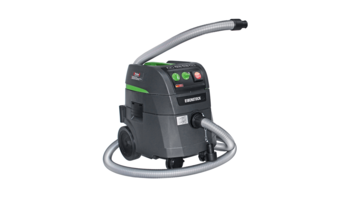
The exhaust system, dust category "M" according to DIN EN 60335-2-69 for 230 V/1~, 50/60 Hz, 1600 Watt is versatile:
For combination with the high performance and small volume cyclones.
To operate the FRITSCH Cyclones you need an exhaust system. The strong airflow ensures simple feeding, increases throughput, and reduces the thermal load of the samples. The high performance and small volume Cyclone separator can be combined with Universal Cutting Mills PULVERISETTE 19, the Variable Speed Rotor Mill PULVERISETTE 14 premium line and classic line. The small volume cyclone can also be combined with the Variable Speed Rotor Mill PULVERISETE 14 premium line and classic line even for passive utilisation – without sample exhaust.
The high-performance cyclone is ideal for combination with the Universal Cutting Mills PULVERISETTE 19 large, the Cross Beater Mill PULVERISETTE 16 and the Disk Mill PULVERISETTE 13 premium line for optimal sample extraction and for comminution of larger quantities.
For cooling of the Variable Speed Rotor Mill PULVERISETTE 14 premium line
By connecting the exhaust system with the connecting piece order no. 14.8128.00, the cooling of the mill can easily be enhanced.
For connecting to Disk Mill PULVERISETTE 13 premium line
The exhaust is simply connected to the PULVERISETTE 13 premium line and operated via a start and stop button on the instrument – for dust free comminution.
For connecting to the Jaw Crusher PULVERISETTE 1, Modell I + II classic line
Simply connect the exhaust system to the integrated connection of the PULVERISETTE 1. Fine dust arising during comminution is automatically removed. The exhaust system is also very useful when cleaning the grinding parts.
For connecting to the Disk Mill PULVERISETTE 13 classic line
The exhaust system can be easily connected to the PULVERISETTE 13 classic line. Fine dust arising during comminution is automatically removed. The exhaust system is also very useful when cleaning the grinding parts.
For exhaustion of the sample during dry measurement with the Laser Particle Sizers ANALYSETTE 22 NeXT
An exhaust system is necessary to ensure automatic sample exhaustion during dry measurement. When the measurement is completed it can also be easily used to manually clean the feeder.
Please note that the exhaust system article no. 43.9070.00, is not equipped with a fine filter and therefore dust may escape. Please consider the valid occupational health and safety regulations. This exhaust system is mostly recommended for dust-free grinding and the vacuuming of during the process developing fine dust in the upper part of the grinding chamber and for the cleaning of the grinding parts.
For vacuuming of the sample during dry measurement with the Laser Particle Sizers ANALYSETTE 22 NeXT, we recommended we recommend the exhaust system article no. 43.9060.00, which is equipped with a hose and an ultra-fine filter of dust class "H" according to DIN EN 60335-2-69, so that the escape of fine dust is reduced.
1 pack = 5 pieces
One pack is included in the order of the exhaust system (article No. 43.9070.00).
These plastic bags should be used for the vacuuming off of coarse, wet materials.
For the vacuuming off of fine, dry materials are paper filter bags available (article no. 43.9055.00).
SUPPORTS
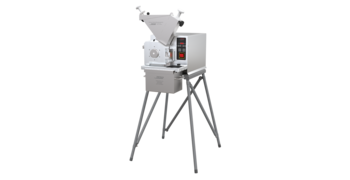
Un support universel et un support complet soudé, à polissage électrochimique, en acier inoxydable 316L et un support à roulettes sont disponibles. Ils représente une base très stable, peu encombrante et à géométrie variable pour le broyeur.
Supports
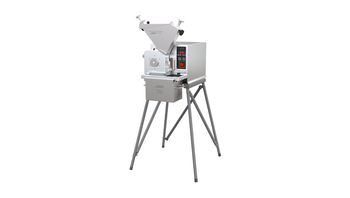
Stand for free installation of the following devices:
Universal Cutting Mill PULVERISETTE 19 variable speed 300-3000 rpm
Universal Cutting Mill PULVERISETTE 19 variable speed 50-700 rpm
Universal Cutting Mill PULVERISETTE 19 variable speed 50-700 rpm large
Universal Cutting Mill PULVERISETTE 19 variable speed 300-3000 rpm Large
Cross Beater Mill PULVERISETTE 16 with grinding insert made of cast iron
Cross Beater Mill PULVERISETTE 16 with grinding insert made of stainless steel
The PULVERISETTE 19 is shown as an example in the photo.
Stand cpl. welded, electrochemically polished made of stainless steel 316L.
This stand is also recommended and used for the free installation the following models of the Universal-Cutting Mills PULVERISETTE 19 300-3000 rpm and 50-700 rpm in the corrosion resistant stainless steel version 316 L, as well as for the PULVERISETTE 19 large 300-3000 rpm and PULVERISETTE 19 large 50-700 rpm.
The stand with wheels offers the Universal Cutting Mills PULVERISETTE 19 a space-saving and spatially variable basis.
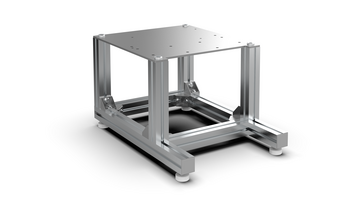
A table-top stand with a height of approx. 330 mm is offered for the Universal Cutting Mills, Both, the PULVERISETTE 19 and PULVERISETTE 19 large can simply be screwed onto the stand.
CERTIFICATION

Documentation IQ/OQ (formulaire - à remplir soi-même) aidant à la qualification du matériel dans le service de gestion de qualité, pour le broyeur universel à couteaux PULVERISETTE 19. large.
CERTIFICATION
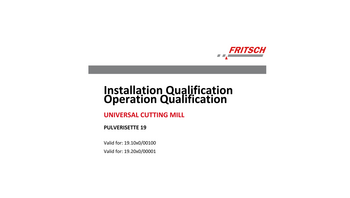
IQ/OQ documentation (questionnaire format - implementation by customer) for the independent utilization for the support of instrument qualification in the quality management system for the Universal Cutting Mills PULVERISETTE 19.







